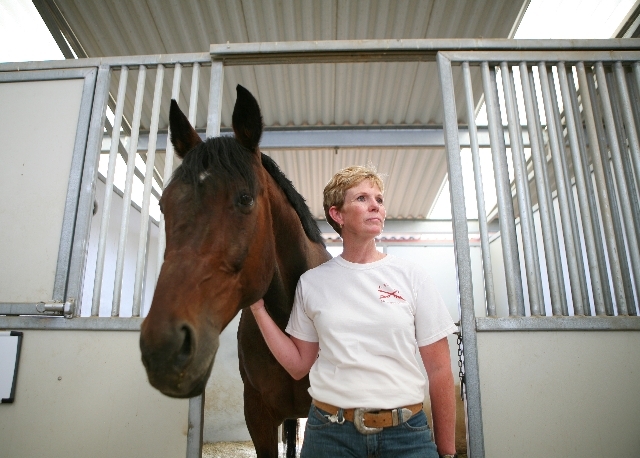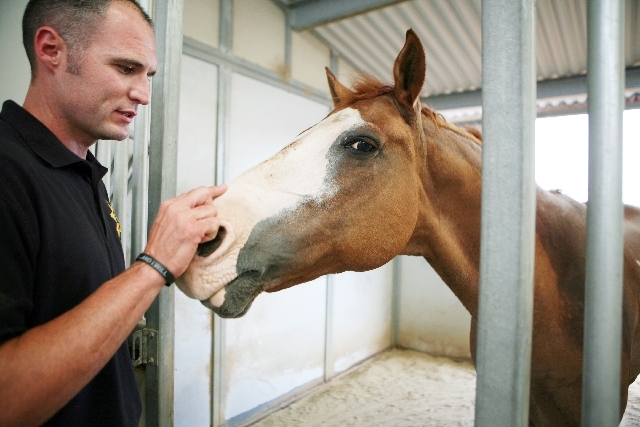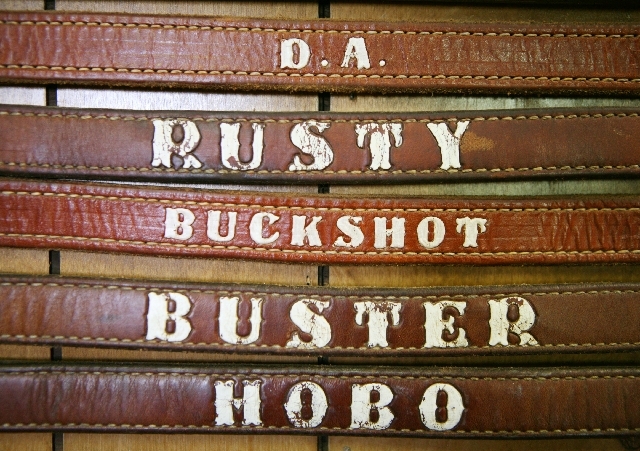Las Vegas police unit runs on 12 horsepower
Their unit was supposed to save Las Vegas from a Y2K catastrophe. With the growing fear of an international computer meltdown, Las Vegas police wanted to make sure they had a unit that didn’t need technology.
The Y2K scare came and went but the Metropolitan Mounted Police Unit, formed July 31, 1998, found a new role in the 15 years since its inception.
They might not come equipped with shrilling sirens or hi-tech computer systems, but the 12 horses — Tigz, Maverick, Doc, Ranger, Max, Nokona, Titan, Morgan, Ace, Mr. T, Ringo and Gunsmoke — are essential to crowd control during Las Vegas’ biggest events.
“It’s been said that one horse equals eight officers,” mounted unit officer Tim Ruiz said. “That’s very important, especially in this town.”
The unit houses 12 officers and four officers off Flamingo and Stephanie roads.
The horses are particularly helpful dealing with protesters or with rowdy crowds, Clark County Sheriff Doug Gillespie said.
“It’s that psyche with a crowd and that horse. It doesn’t incite a crowd. People respect them, but they’re not threatened by them. Hang out one time when you see them in a crowded area, and you’ll see they’re worth their weight in gold.”
CROWD CONTROL
All four mounted officers patrol the Strip every Friday and Saturday night. The unit is also used for events like the Electric Daisy Carnival, NASCAR and New Year’s Eve.
Gillespie said he was the captain overseeing the Strip when horses were introduced and was a strong supporter.
“It’s an aspect of our department where the true value is only recognized a few times a year, but it is a huge help in managing crowds,” Gillespie said. “We have to stay committed to it .”
Because of their large stature — each horse weighs 1,000 to 1,300 pounds — and innate flight response, it takes years of training to handle the fast-paced streets of Las Vegas.
“The horses are just a gentle way of moving a lot of people,” Lt. Jack Clements said. “If there’s any event that has a heavy concentration of people, we’re sending the horses down.”
Clements, a 21-year Metropolitan Police Department veteran, has been a strong advocate for the mounted unit. He looks at it as a large-force multiplier, because the horses can be more effective than street officers at crowd control.
Although the horses can move a large group of people quickly, they also have the tendency to scare very easily.
“Something so simple like a plastic bag, a bird or a rabbit can spook them. That’s our biggest fear,” Ruiz said.
Clements said the horses are a very valuable resource that people don’t think about. “It’s not an expensive unit. And from a crowd standpoint it’s a very effective unit. Whenever our horses walk through crowds on the Strip it’s like parting the Red Sea. Nobody wants to get run over by a horse.”
CARE AND TRAINING
The four officers assigned to the unit care for the stable. They wash the horses, and exercise and feed them twice a day. Not all of the horses have the same diet; some are able to eat hay, while others eat oat nuggets to regulate their diets.
When searching for new horses, mounted unit officer Cindy Smith said temperament and size have plenty to do with the ones they pick.
Horses for the unit must be geldings, Smith said. “We don’t have any female horses. If we did the other horses would act differently.”
Geldings are more mature and can focus more on the task at hand, which is why the mounted officers prefer their four-legged members to be between the ages of 8 and 12. They also prefer all the horses to be the same color as the rest of the stable for uniformity, Smith said.
“Just like we all match, we want them to match as well. It looks more professional.”
Since the horses are exposed to the public for crowd control, the two years of training is key, Ruiz said.
“A horse doesn’t want to bump into you and hurt you,” he said. “The horse has a mind of its own, and it is a challenge. It takes a lot of training.”
Mr. T, a 20-year-old brown appaloosa, was the first to join the unit in 1998. Donated by then-Terrible’s Casino, he was injured when he fell after being clipped by a car a few years ago.
Smith said the retirement age for their horses is between 20 and 23, but she said Mr. T has a few years left in him. A horse’s average life span is 30 years.
When horses are forced to retire, they are offered for sale to their rider for one dollar. If the officer is unable to take the horse, former members of the unit are able to purchase them for a dollar.
“There are so many different things they’re good at,” Smith said. “They add something to the unit that nobody else can offer.”
CHOOSING OFFICERS
When an event requires more than four horses, volunteers are called in. On New Year’s Eve, all 12 horses hit the streets, with at least eight volunteers on their backs.
Officers interested in joining the unit must have at least three years of street patrol experience and preferably a familiarity with horses.
The unit holds two, 40-hour schools per year to train volunteer officers. The beginner’s school emphasizes horsemanship, ground work and being able to control the horse. Most volunteers are invited back to the advanced class a couple of months later to focus on the law enforcement aspect of the unit, including patrol procedures and defensive tactics.
Candidates must pass a question and answer process, perform physical tasks like lifting a bail of hay, pushing a wheelbarrow and mounting and riding a horse.
“All of us have years of experience and different levels of expertise with horses,” Smith said. “You can’t just be a rookie coming out with us.”
She worries that mounted units are the first to go when departments face budget cuts.
In 2009, the unit was the closest it had been to ceasing operations because, Smith said, it was the first year where the department was facing major cuts.
“Everyone was being examined at that time. Just like in every department across the country, the mounted unit is always one of the first things to go.”
Clements emphasized the importance of a mounted unit in a city where large crowds gather in close proximity.
“You’d need about 10 to 12 officers to do what two horses can do,” he said. “Instead of spending money on more officers, we just send in the horses. It’s so worth the money.”
Reporter Mike Blasky contributed to this report. Contact Steven Slivka at SSlivka@reviewjournal.com or 702-383-0264.




















